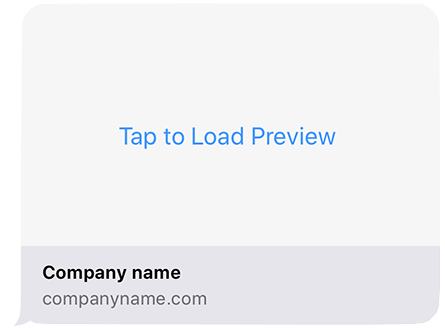Sending Rich Link Messages
The Messages app on Apple devices protects user privacy and security by not allowing a remote sender to trigger the user’s device to access internet resources without their knowledge or permission. When a URL is sent to a user’s device, a preview bubble appears. If the rich link feature is not used, the URL is treated as untrusted. A blank bubble appears with the website domain and the label “Tap to Load Preview.” This allows the user to see the domain name of the site, and chose whether they want to load a preview before opening the link in a web browser. This experience tends to discourage users from tapping to open the link, and is unacceptable in the Messages for Business experience.
When a business sends a URL to a user using rich links, the user can see a preview of the web page. This reassures them that they aren’t being tricked into visiting a malevolent website.
Sending URLs using Rich Links
When a business sends a URL with an inline image or video to a customer, the customer receives a "Tap to Load Preview" message (second image below). You need to remove the "Tap to Load Preview" step by using the Messages for Business REST API, see Exercise: Rich Links.


Exercise: Rich Links
By default, the Messages app renders a URL with a warning to the user. The warning asks the user to "Tap to load" before displaying an image from the linked page and showing the full URL. The rich link feature of Messages for Business allows a brand to send a link without the "Tap to load" step.
There are two types of rich links: image and video. Choose image type to link to a webpage that
provides a visual indication of what the user can expect. Choose video type only
when linking directly to a video media asset, such as an MP4 file.
In the samples directory, you'll find a payload for each type for your reference.
See rich_link_image.json and rich_link_video.json.